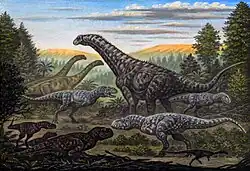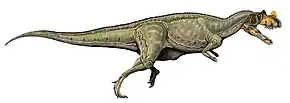| Laevisuchus Temporal range: Late Cretaceous, | |
|---|---|
 | |
| Cervical vertebra K20/613 in multiple views | |
| Scientific classification | |
| Domain: | Eukaryota |
| Kingdom: | Animalia |
| Phylum: | Chordata |
| Clade: | Dinosauria |
| Clade: | Saurischia |
| Clade: | Theropoda |
| Family: | †Noasauridae |
| Genus: | †Laevisuchus Huene & Matley, 1933 |
| Type species | |
| †Laevisuchus indicus | |
Laevisuchus (/ˌlɛvɪˈsjuːkəs/, "light crocodile") is a genus of theropod dinosaur from the Late Cretaceous. Its remains were discovered by Charles Alfred Matley near Jabalpur in Maastrichtian deposits in the Lameta Formation in India, and were named and described by paleontologists Friedrich von Huene and Matley in 1933.[1] The type species is Laevisuchus indicus. The generic name is derived from Latin laevis, "light" and the Greek name for the ancient Egyptian crocodile god, Soukhos. The specific name means "Indian" in Latin. It is known only from three cervical vertebrae (GSI K20/613, GSI K20/614 and GSI K27/696) and a dorsal vertebra (GSI K27/588). A holotype was not assigned by Huene and Matley and a lectotype has never been chosen from the syntypes. All remains except GSI K27/696 were lost; GSI K20/613 was rediscovered in 2012.
Description
Laevisuchus was a small bipedal carnivore. In 1998 David Lambert estimated it was some two metres (6.6 ft) long, 0.9 meters (3.0 feet) high, and approximately 30 kg (66 lb) in weight.[2]
Classification

Laevisuchus was originally classified by Huene as a coelurid due to the similarity of its vertebrae with those of Aristosuchus. However, an analysis in 2004 has shown it to be an abelisauroid because of its long epipophyses, a pair of foramina on the centrum, and low and triangular neural spines. The vertebrae specifically resemble those of noasaurids like Masiakasaurus and Noasaurus due to having more anteriorly placed neural spines and posteriorly reduced epipophyses[3][4]
See also
References
- ↑ F. v. Huene and C. A. Matley, 1933, "The Cretaceous Saurischia and Ornithischia of the Central Provinces of India", Palaeontologica Indica (New Series), Memoirs of the Geological Survey of India 21(1): 1-74
- ↑ Lambert, D. (1998). The Wordsworth Book of Dinosaurs, Britain: Mackays of Chatham PLC.
- ↑ Tykoski, R.S. & Rowe, T. (2004). "Ceratosauria". In: Weishampel, D.B., Dodson, P., & Osmolska, H. (Eds.) The Dinosauria (2nd edition). Berkeley: University of California Press. Pp. 47–70 ISBN 0-520-24209-2
- ↑ Novas, Fernando; Agnolin, Federico; Bandyopadhyay, Saswati (2004). "Cretaceous theropods from India: A review of specimens described by Huene and Matley (1933)". Revista del Museo Argentino de Ciencias Naturales, nuevo serie. 6 (1): 67–103.
External links
- Dinosaurier-Info (in German)

.jpg.webp)












